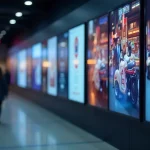Custom plastic retail bags do more than carry products—they carry your brand. A sharp design, clear logo, and thoughtful handle placement turn a simple shopping bag into a marketing asset. Whether it’s swinging from a shopper’s wrist downtown or folded neatly in someone’s trunk, these bags become walking advertisements that extend the store’s reach long after checkout.
Retailers who invest in the right bag design build stronger brand identity. It’s about more than holding merchandise—it’s about crafting a customer experience that sticks. We borrowed some tips from industry leader, Prime Line Retail on custom plastic retail bags, to help create this useful content for you to glean from. Hopefully it helps your business succeed!
Why Custom Plastic Bags Matter for Retail Success
Plastic bags remain a retail staple because they check off so many boxes. They’re durable, affordable, lightweight, water-resistant, and easy to store. More importantly, they’re highly customizable. With full-color printing, custom shapes, and branded handles, plastic bags become part of a brand’s voice.
They also offer something many other packaging types don’t: visibility. A well-designed bag leaves the store and goes everywhere the customer does. From city streets to subway rides, that bag builds recognition with every glance.
Material Options and Their Benefits
Custom plastic bags aren’t one-size-fits-all. They come in several materials, each with unique strengths:
- Low-density polyethylene (LDPE): Soft, flexible, and great for clear or semi-transparent styles.
- High-density polyethylene (HDPE): Thinner, stronger, and excellent for lightweight bulk orders.
- Biodegradable plastics: Break down over time with proper disposal, depending on local regulations.
- Non-woven polypropylene: Thicker, reusable material ideal for high-end retail or loyalty gifts.
The right choice depends on what the store sells, how much the product weighs, and whether the bag is meant for single or multiple uses.
Common Styles of Custom Plastic Retail Bags
Retail bags can be tailored not just in material, but in form. Here are the most popular styles in circulation:
- Flat poly bags: Simple and effective for lightweight goods.
- Gusseted bags: Feature expandable sides or bottoms to hold more volume.
- Zip-top resealable bags: Perfect for cosmetics, accessories, and tech components.
- Loop-handle and die-cut handle bags: Offer both comfort and durability in transport.
Each format has its own place in retail, depending on how the customer is expected to carry the product and how long the bag needs to last.
Balancing Durability with Sustainability
There’s no ignoring the growing interest in sustainable practices. Retailers looking to strike a balance between function and responsibility are turning to:
- Reusable designs: Encourage customers to reuse the bag, extending its lifespan.
- Thicker plastic film: Often allowed under plastic bag regulations due to their reusability.
- Clear recycling instructions: Printed on the bag to guide proper disposal.
- Alternative materials: Options like post-consumer recycled plastic or biodegradable blends.
It’s not always about replacing plastic. Sometimes it’s about making smarter decisions with the plastic used.
Printing and Finishing Options That Add Value
What a customer sees and feels matters. The bag may be made of plastic, but it should never feel cheap. Thoughtful finishing can elevate perception. Popular printing and finishing techniques include:
- Flexographic printing: Ideal for high-volume orders and solid branding.
- Digital printing: Perfect for smaller runs, prototypes, or seasonal promos.
- Offset printing: Provides detail-rich visuals and sharp text.
- Spot UV or soft-touch finishes: Add a tactile and visual edge.
- Foil stamping or embossing: Make logos pop and create premium appeal.
A well-printed bag adds brand value without needing extra effort at the register. It tells customers they’re shopping somewhere that cares about every detail.
Custom Bags as Walking Advertisements
A custom bag is more than a container—it’s a mobile brand experience. Whether it’s a bold logo, a witty phrase, or a pattern unique to the season, the design lives on long after the purchase. Customers carry them through malls, sidewalks, offices, and public transit. That’s dozens—sometimes hundreds—of impressions from a single bag.
Unlike digital ads, these impressions feel natural and earned. There’s no scroll past. No mute button. Just a physical object with staying power.
Sizing, Thickness, Volume, and Cost Considerations
The right balance of size, gauge, and finish makes a bag effective. Here’s what retailers need to think through:
- Dimensions: Should fit the product without feeling oversized or flimsy.
- Thickness: Heavier products call for a thicker gauge. Thinner bags may tear if overloaded.
- Order volume: Higher quantities typically reduce per-unit costs.
- Storage space: Thinner film bags are easier to store in bulk.
- Seasonality: Limited-edition designs may justify a smaller print run at a higher cost.
These decisions impact both performance and perception. A flimsy bag feels like a cost cut. A sturdy one feels like brand care.
Legal Compliance and Retailer Responsibilities
Plastic bag regulations vary widely. Some areas restrict single-use bags entirely, while others allow thicker reusable versions or charge fees to reduce waste. Retailers must:
- Check local laws before ordering bulk inventory
- Clearly label bags with recyclable or reusable messaging
- Educate staff on what to offer when customers ask about bag options
Using compliant materials not only avoids fines but signals a commitment to doing things right.
Real-Life Uses of Custom Plastic Bags
Different retail verticals put plastic bags to work in unique ways:
- Fashion boutiques use high-gloss loop-handle bags for elegance.
- Toy stores print bright characters and logos on die-cut handle bags for instant kid appeal.
- Electronics shops opt for zip-top plastic pouches that keep parts, receipts, and cables together.
- Pop-up markets often use reusable non-woven bags with bold one-color prints that double as giveaways.
Each one tells a story. Each one extends the brand beyond the storefront.
FAQ: Everything You Need to Know About Custom Plastic Retail Bags
What’s the best material for a reusable plastic retail bag?
Non-woven polypropylene and thicker LDPE films both work well for reusable options. They can be wiped down, folded, and repurposed multiple times.
Can plastic retail bags be customized in small quantities?
Yes. Many suppliers offer low minimum order quantities for digital or short-run printing. It’s ideal for seasonal promotions, startups, or market testing.
Do thicker plastic bags help meet legal requirements?
In many regions, yes. Bags over a certain gauge are considered reusable and fall outside single-use bans. Always check local guidelines.
Are printed plastic bags recyclable?
It depends on the type of plastic and the recycling facility. Most thin plastic bags must be returned to store drop-offs, not curbside bins. Clear recycling instructions help customers dispose of them properly.
How much do custom plastic retail bags cost?
Cost varies by size, thickness, quantity, and printing method. Larger volumes bring prices down, especially with simpler designs.
Can plastic bags be made with recycled materials?
Yes. Many manufacturers now offer options that include a percentage of post-consumer recycled content, helping reduce resource use.
What’s the typical lead time for production?
Expect four to six weeks for most orders after artwork approval. Rush orders may be available depending on materials and print complexity.
What types of printing work best for plastic bags?
Flexographic printing is best for bulk runs. Digital printing suits short runs or detailed designs. Offset printing gives superior color accuracy.
Are custom plastic bags more effective than paper?
They’re more durable and longer-lasting in most cases. For visibility and reuse, plastic often outperforms paper—especially when designed with care.
Final Thoughts
Retail is competitive. Every touchpoint matters. Custom plastic bags offer a simple, cost-effective way to stand out, reinforce your brand, and keep customers thinking about you long after they leave the store. The right bag doesn’t just hold a product. It holds attention, loyalty, and identity.
If your goal is to create a more memorable in-store experience and drive visibility on the street, your packaging should work as hard as your products. Make the bag part of the brand. Make it count.







